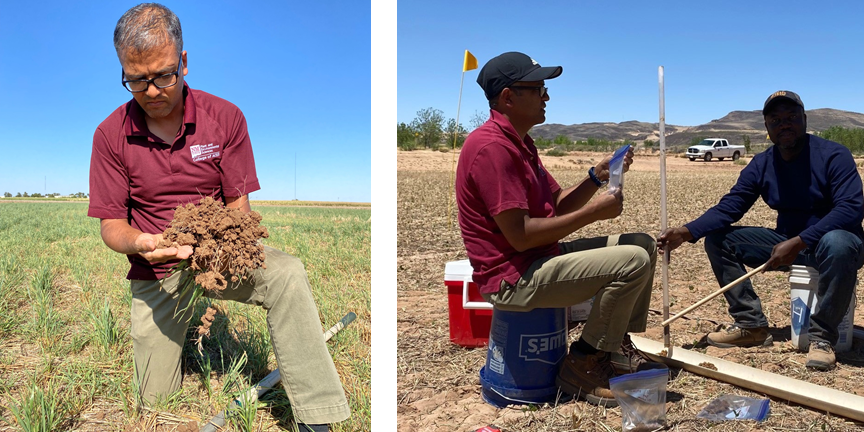Soil is much more than just a mineral substrate for plant growth, especially when it comes to soil health. If we dig a hole in soil that has been undisturbed for a long time, we might notice how soil particles clump together and that there are airspaces between the clumps. We may also see decaying organic matter, some roots and perhaps a worm or two. The air spaces and root channels in this soil means it will be well-drained, while its organic matter content allows it to retain moisture. The Natural Resources Conservation Service (NRCS) describes soil health as “the continued capacity of soil to function as a vital living ecosystem that sustains plants, animals, and humans.” For the farmer, healthy soil regulates water, sustains plant and animal life, effectively filters and buffers pollutants, and promotes nutrient cycling. An unhealthy soil is characterized by poor physical structure and depleted organic matter. It will be more susceptible to erosion by surface flooding or wind shear, or conversely, it may be water-logged. Low microbial activity and sub-optimal pH levels in an unhealthy soil also impedes nutrient cycling and diminishes its ability to buffer pollutants.
Image

Interest in soil health practices is growing in the Southwest, but adoption rates remain low, partly due to limited information on how specific practices might impact water availability or soil nutrients in arid or semi-arid soils (Ghimire et al., 2023; Acharya et al., 2024). Another challenge is that arid land soils naturally have very organic matter content (less than 2%), and the lack of water inhibits the biological processes that help build organic matter (Ghimire et al., 2023).
Rajan Ghimire and his team at New Mexico State University’s Agricultural Science Center at Clovis are working to answer some of the questions that face soil health practitioners in arid and semi-arid lands. Growing cover crops in the off-season is one of the strategies that a farmer can use to build soil health. Cover crops, as the name suggests, can be used to cover the soil surface to prevent soil loss through erosion and to suppress weeds. Below the soil surface, cover crop roots improve soil structure which in turn helps water infiltration and aeration. Cover crops also promote nutrient cycling in the soil profile by transporting nutrients from deeper layers and releasing them as they die and decompose. Through decomposition, cover crops contribute to soil organic content and provide an energy source for soil microbial communities (Acharya et al., 2024). Cover crops have also been shown to facilitate carbon sequestration in the soil and because of this, cover cropping features as a Conservation Practice on the NRCS list of Climate-Smart Agriculture and Forestry Mitigation Activities (NRCS, 2024).
Cover cropping does not yield the same results across different soils, different climates, and different systems. Likewise, crops that may work well in one location, may not be the optimum choice for another location. With this in mind, Ghimire's team have been testing different mixtures of cover crops in a semi-arid, irrigated, no-till crop system (silage corn-sorghum rotations) to see how these affect the growth and activity of microbes in the soil that are responsible for increasing soil organic carbon and soil nitrogen. The cover crops they have been testing are native grasses, brassicas, and legumes - all species that grow well in dry climates. Overall, they found that cover crops increased soil organic carbon accumulation, soil organic nitrogen, and enhanced microbial activity (although it took three years before they saw increases in some of the indicators of soil health).
Ghimire's team have also been exploring the impact of occasional tillage on soil organic carbon and nitrogen. No-tillage or minimum tillage is another soil health practice that is on the NRCS list of Climate-Smart Agriculture and Forestry Mitigation Activities (NRCS, 2024). While there is plentiful evidence that demonstrates the benefits of reducing disturbance to soils, strict no-till practices sometimes have their downsides. Tillage is traditionally used to control weeds, so in no-till farming there can be increased reliance on herbicides, and herbicide overuse increases the risk of resistance in weed populations. Soil nutrient and soil organic carbon stratification may also occur in no-till systems, reducing nutrient availability for plants. Soils may also become more acidic and more compacted. Ghimire's team have shown that implementing one stubble-mulch tillage practice in a six year stretch of continuous no-till management did not adversely impact soil organic carbon and nitrogen, and they note the benefit of occasional disturbance in a no-till system includes the opportunity to incorporate crop residue with the soil and to alter the stratification of soil organic carbon (Thapa et al., 2023).
For more information:
Extension circular 704: Using Cover Crops in New Mexico: Impacts and Benefits of Selecting the Right Crops
Extension circular 694A: Executive Summary: Soil Health—Importance, Assessment, and Management
Extension circular 694B: Soil Health—Importance, Assessment, and Management
Video: Soil Health on Arid and Semiarid Farms: Tillage and Cover
Video: Carbon Farming in Agroecosystems
Infographic: Effects of Cover Crops on the Soil
NRCS (2024): Climate-Smart Agriculture and Forestry (CSAF) Mitigation Activities List for FY2024
Peer-reviewed publications
Acharya, P., Ghimire, R., & Acosta-Martínez, V. (2024). Cover crop-mediated soil carbon storage and soil health in semi-arid irrigated cropping systems. Agriculture, Ecosystems & Environment, 361, 108813.
Ghimire, R., Thapa, V. R., Acosta-Martinez, V., Schipanski, M., Slaughter, L. C., Fonte, S. J., ... & Noble Strohm, T. (2023). Soil health assessment and management framework for water-limited environments: examples from the Great Plains of the USA. Soil Systems, 7(1), 22.
Thapa, V. R., Ghimire, R., Paye, W. S., & VanLeeuwen, D. (2023). Soil organic carbon and nitrogen responses to occasional tillage in a continuous no-tillage system. Soil and Tillage Research, 227, 105619.





